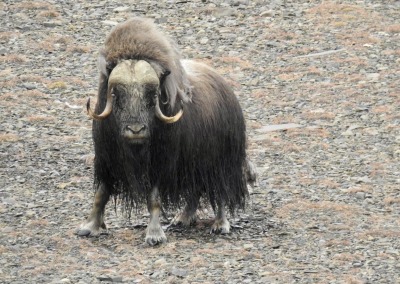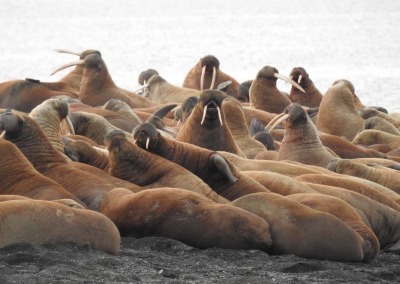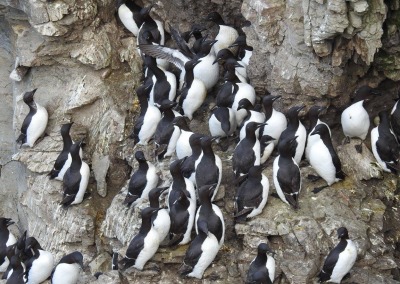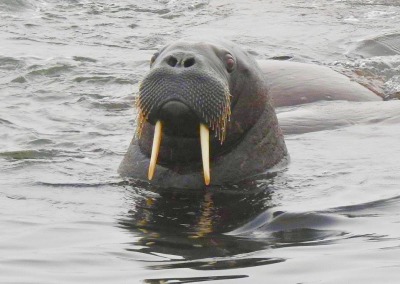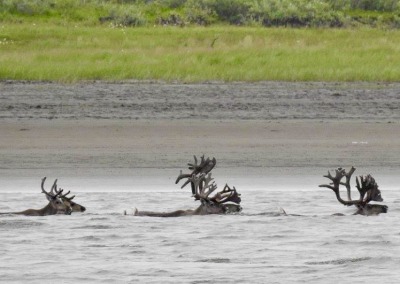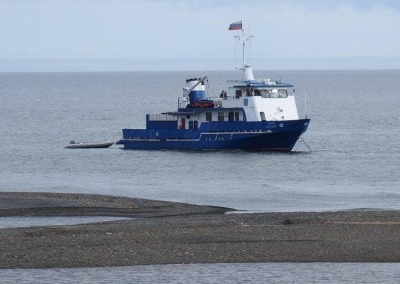Taymyr Peninsula: polar bears, walrus and muskox
Tour Overview
Highlights
- Spotting polar bears
- Visiting large walrus colonies
- Seeing herds of wild reindeer swimming across the river
- Spotting muskox
- Visiting a colony of over 1 million birds
- Seeing beluga whales, seals, snowy owls, lemmings and Arctic foxes
- Meeting indigenous Dolgan hunters, reindeer herders, fishermen and mammoth tusk hunters
- Visiting the bizarre rock formations and abandoned polar research station on Begichev Island
- Visiting Nordvik gulag, formerly the northernmost inhabited place in Russia
Itinerary
Day 1: Fly into Krasnoyarsk
Fly in to Krasnoyarsk. Afternoon city tour. Overnight in hotel.
Day 2: Fly to Khatanga
Group flies 4 hours north from Krasnoyarsk to Khatanga, population 2,500, a village 700km north of the Arctic Circle. Visit local ethnographical museum and underground museum hacked into the permafrost itself, where remains of locally found mammoths are preserved. Note: if the museum owner happens to be away on holiday during our tour, it will not be possible to visit it, as he refuses to leave the keys with locals.
Excursion around the village. At this time of year, the world’s largest reindeer herd (over 1 million animals) is migrating right past Khatanga. Reindeer can be seen right outside the village swimming across the Khatanga River, and often even running through the village itself.
Overnight in guest house.
Day 3: By ship north to the Taymyr Peninsula
Group travels north down the river towards Cape Tsvetkova. Our boat has 16 beds for guests. It is an ocean-class boat but will still be heavily affected if there is ice around the mouth of the river. For this reason, the second half of August and first half of September are really the golden window of opportunity for this trip. The ice will have disappeared but the stormy weather that characterizes September will not yet have begun.
The ice retreating, as well as making access easier for the ship, also means that the walrus colonies move off the ice and onto sand spits extending from the mainland. We know the locations of the sand spits where these walrus colonies form every year. They will of course be among our prime destinations. And, of course, when there is a walrus colony, there will also be polar bears nearby, living and sleeping within a few hundred metres of the walrus colony and feeding on them when hungry.
The other advantage of doing the trip in the second half of August or first half of September is that the migration of the world’s largest reindeer herd (1 million head) is crossing the Khatanga River at this time. So while sailing north up the river to Tsvetkova Point we will very likely see many groups of reindeer swimming across the river in front of and behind our boat and running along the river banks.
On the way, we will also pass extremely isolated indigenous Dolgan villages such as Novorybnaya and Syndassko (the second most northern settlement in Eurasia). We can stop to visit them if desired. The inhabitants live by reindeer herding, hunting wild reindeer, fishing and hunting for woolly mammoth tusks.
After around 15 hours we come out of the River Khatanga and into the Gulf of Khatanga, part of the Laptev Sea which is in turn part of the Arctic Ocean. Here we may see seals and Beluga whales. After exiting the Gulf of Khatanga we continue north, sailing through the Laptev Sea while following the coast of the Taymyr Peninsula.
The total journey time from Khatanga to Cape Tsvetkova will be roughly 30 hours if no ice has been blown down onto the river. If ice has been blown down it may take longer.
Day 4: Arrival at Cape Tsvetkova
Group arrives at Cape Tsvetkova. When the ice retreats, a large walrus colony forms on the sand spit here every year. Several polar bears live next to the colony, killing walrus whenever they get hungry.
We will take a motorboat from our ship to the sand spit to photograph the walrus. We can get to within about ten metres of them. If there are polar bears nearby, we will attempt to photograph them from the boat. If this is not possible, we will disembark and approach them gradually but will not move far away from the motorboat. If they start showing us too much attention, we will retreat to the boat. We will be with two armed, trained, experienced biologists all the time.
Day 5: Cape Tsvetkova
Hike or travel in motorized dingy along Tsvetkova Point to observe walrus, polar bears, muskox and a large number of bird species such as black-throated loon, various ducks and eider.
Day 6: Cape Tsvetkova
Hike or travel in motorized dingy along Cape Tsvetkova to observe walrus, polar bears, muskox and a large number of bird species such as black-throated loon, various ducks and eider.
Sometimes, particularly in the evening, dozens or even hundreds of the walrus will swim up to the boat, as interested in us as we are in them. This provides an excellent opportunity to photograph them close up in the water.
Day 7: Cape Tsvetkova
Trip to a nearby UNESCO World Heritage site with high cliffs, glacial cirques and buttes sticking out into the sea. Chance of seeing birds, polar bears, arctic fox, lemmings, snowy owls and muskox.
Day 8: To the Yakutian islands
Today we cross the border from Taymyr to Yakutia (the coldest inhabited part of the world) and visit Preobrazheniya Island (Transfiguration Island) in the Laptev Sea. On the island’s high cliffs, over 1 million birds can be seen nesting. There are many species of gulls, including the very rare Sabine, and many guillemot too. There is also a large walrus rookery on the sand spit here and, as a result, polar bears.
The cacophony (and the smell!) produced by one million nesting birds is one of the most memorable and, literally, jaw-dropping experiences of the whole trip for many of our guests.
Day 9: Preobrazheniya Island
Group does a hike up to the top of Preobrazheniya Island to view the bird cliffs from above. On the way, good chance of seeing polar bears, lemmings, Arctic fox, snowy owls and more.
Day 10: Begichev Island and Nordvik gulag
Sail south to Begichev Island. Here we will see bizarre rock formations on the coast, visit the remains of an abandoned polar research station and have a chance of seeing muskox and reindeer.
From Begichev we will sail south to the mainland, where we will visit Nordvik gulag, formerly the northernmost inhabited place in Eurasia. The prisoners here were digging for salt, which was used to supply Russia’s northern fisheries. The gulag was closed in the 1940s and the settlement around it was abandoned in 1956, but a several buildings and some machinery remain.
Day 11: River Novaya
Today we head south back in the direction of Khatanga. On the way, we stop to visit camps of Dolgan fishermen and mammoth tusk hunters on the banks of the River Novaya. At this time of year, the migration of Arctic char, some of which can weigh over 30 kg, is passing through this river.
More chances to see reindeer swimming across the river or running on its banks.
Day 12: Arrival in Khatanga
Arrival in Khatanga. If we have spare time, we can visit the crafts centre, where local artisans make objects from mammoth tusk, walrus tusk and reindeer antlers. Overnight in guest house.
Day 13: Fly to Krasnoyarsk
Group flies from Khatanga to Krasnoyarsk. Overnight in hotel.
Day 14: Krasnoyarsk Pillars
Group has a half day to relax and a half-day trip to the famous Krasnoyarsk Pillars National Park.
Day 15: Fly home
Group flies home.
The above itinerary includes rental of the ship for 9 days. However, the rental period can be reduced to 6 days, making the trip cheaper. We will still have time to visit all the places listed on the itinerary, but will not be able to spend so much time searching for animals in each. Please see the prices for different rental periods below.
Tour price with ship rental for 6 days
Number of people: {{ currentPerson }}
Price per person: $ {{parseFloat(price).toFixed(0)}}
Tour price with ship rental for 7 days
Number of people: {{ currentPerson }}
Price per person: $ {{parseFloat(price).toFixed(0)}}
Tour price with ship rental for 8 days
Number of people: {{ currentPerson }}
Price per person: $ {{parseFloat(price).toFixed(0)}}
Tour price with ship rental for 9 days
Number of people: {{ currentPerson }}
Price per person: $ {{parseFloat(price).toFixed(0)}}
Price includes:
- Flights Krasnoyarsk – Khatanga – Krasnoyarsk
- Ship rental, crew’s salaries and expenses, fuel, etc
- 2 armed Russian guides / motorboat drivers plus all their expenses. Both are very experienced Arctic biologists and fully qualified to defend groups from polar bears if necessary, as well as being first aid trained.
- Services of our own private cook while on the ship
- All transfers in Krasnoyarsk and Khatanga
- All accommodation in Krasnoyarsk in ensuite twin or double rooms in a 4* hotel. Accommodation in Khatanga in a simple hotel or guest house. Accommodation on the ship in 4-berth cabins with simple beds (identical to beds on a Russian train) and closed off by curtains, not doors.
- All meals
- All permits required for the region
- English- and Russian-speaking guide accompanying the group from Krasnoyarsk
- Letter of invitation for 30-day Russian tourist visa
- Satellite phone for emergency calls
Price does not include:
- Transfers, accommodation, food or guiding in Moscow. This can be added at extra cost if so desired.
- Flights to and from Krasnoyarsk. These can be added at extra cost if so desired.
- Personal travel insurance or medical insurance
- Personal expenses
- Clothing or equipment
- Satellite phone for personal or work-related calls. You can purchase minutes for $2 per minute.
- Extra expenses caused by bad weather, flight delays or other force majeure situations

